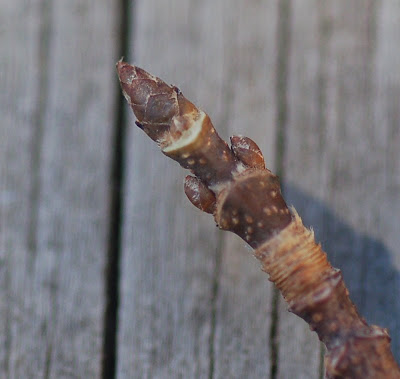
After reading Dave's Invasion of the Swamp Things, I began to lose my nerve. It's not that I was frightened to learn that red maple (Acer rubrum) is now the most common tree in Pennsylvania. It's just that I never see red maples around here. I began to worry that I could no longer tell one maple from another, that the trees I've been blithely calling Sugar Maple (Acer saccharum) actually were Dave's ubiquitous Acer rubrum.
Eventually I was reassured by Gray's Manual of Botany and some Internet resources. The dominant maple here on Droop Mountain is indeed Acer saccharum, Sugar Maple. I expect this is because Droop Mountain has been cleared farm land since the early 1800's, and because many farmers kept a sugar bush for making maple syrup. The fencerow full of big sugar maples here on our place is what's left of such a sugar bush.

Although samaras were scarce this year because of the hard freeze we had in April, I found these diagnostic maple seeds in the yard. Sugar Maple (and Black Maple) have these "horseshoe-shaped" samaras, while the twin seeds of Red Maple come to a sharp point where they meet the peduncle.

The leaf buds on Red Maple are blunt, but these sharply pointed buds are characteristic of the "Hard Maples," Sugar Maple and Black Maple (Acer nigrum). Given my mood of self-doubt, I had to go back to Gray's Manual, to check whether I had Sugar Maple or Black Maple. The delicate lenticels on these twigs are characteristic of Sugar Maple. On Black Maple twigs, the lenticels are large and raised, and the older twig regions are waxy, and tend to peel. I still know one maple from another.
Some maple identification links:
- Maple Tree Identification from the Massachusetts Maple organization; the same text and photos as found on Maple Tree Identification from Maple-trees.com, which sells trees.
- USDA Plants Database entry for Black Maple
- USDA Plants Database entry for Red Maple
- USDA Plants Database entry for Sugar Maple
- Maple Identification guide from the Cornell Sugar Maple Research and Extension Program; for kids, with nice photos.
3 comments:
I always just look at the bark. But yeah, it's quite possible to have whole mountainsides covered with sugar maple. On our 640 acres there are a few decent-sized sugar bushes which I'm pretty sure are natural.
One of PA's few insects to make it onto our state endangered species list is an old-growth sugar maple obligate, the sugar maple longhorn beetle. Might be something to keep an eye out for if you have and really big sugar maples around.
It's not the prevalence of sugar maples, but the absence of red maples, that puzzles me. I've gone looking for red maples in the spring when they're easiest to spot (love those inflorescences!), and they aren't around. Time to search the swamps, I guess.
Is that beetle Glycobius speciosus? We have lots of very old, very diseased sugar maples on this hillside, so it's something to watch for.
Yes. And foresters are still encouraging commercial sugar harvesters to spray for it, despite its rarity.
As I suppose you know, longhorn beetles in general are now being looked at as good old-growth indicators.
Post a Comment